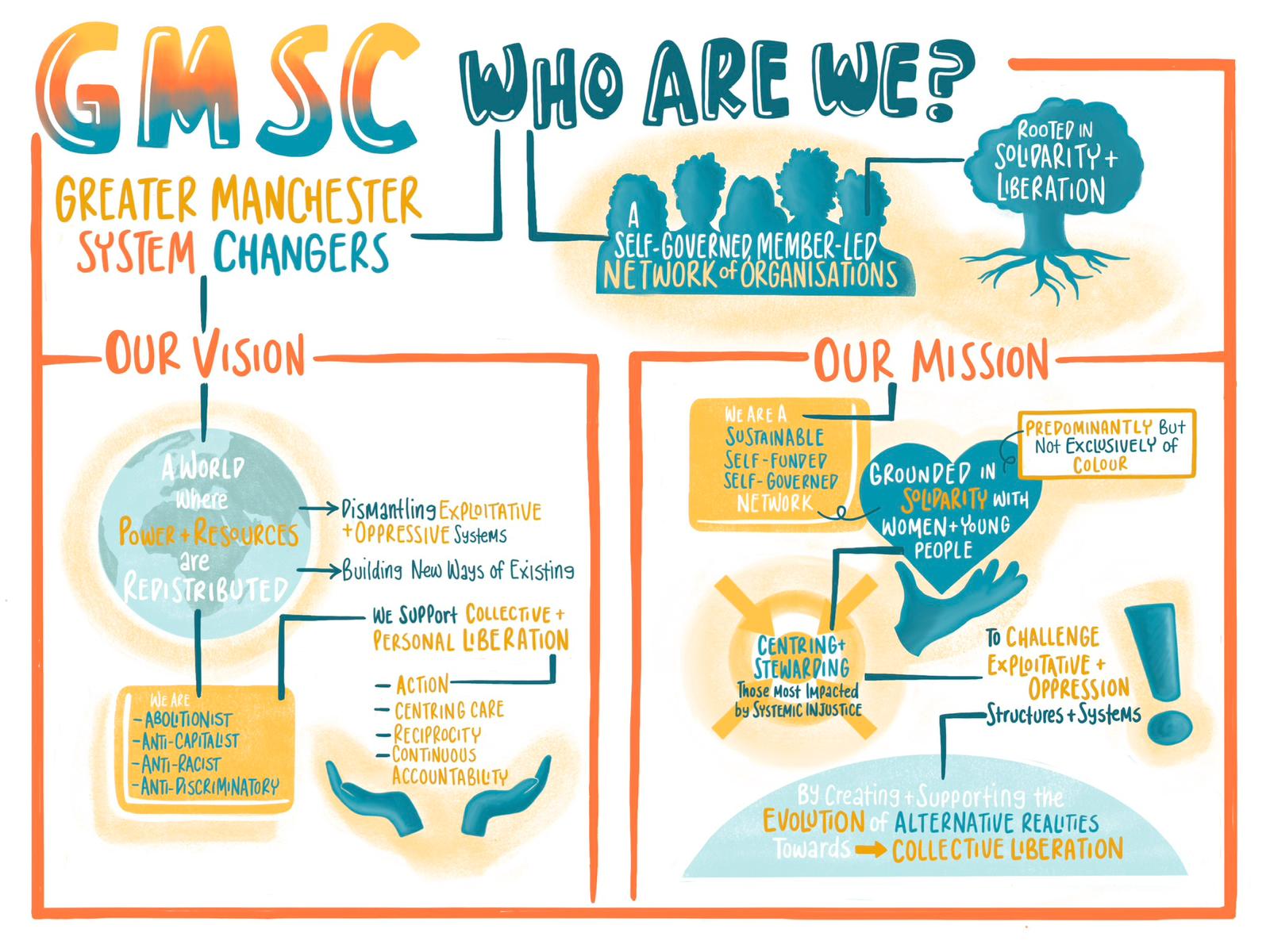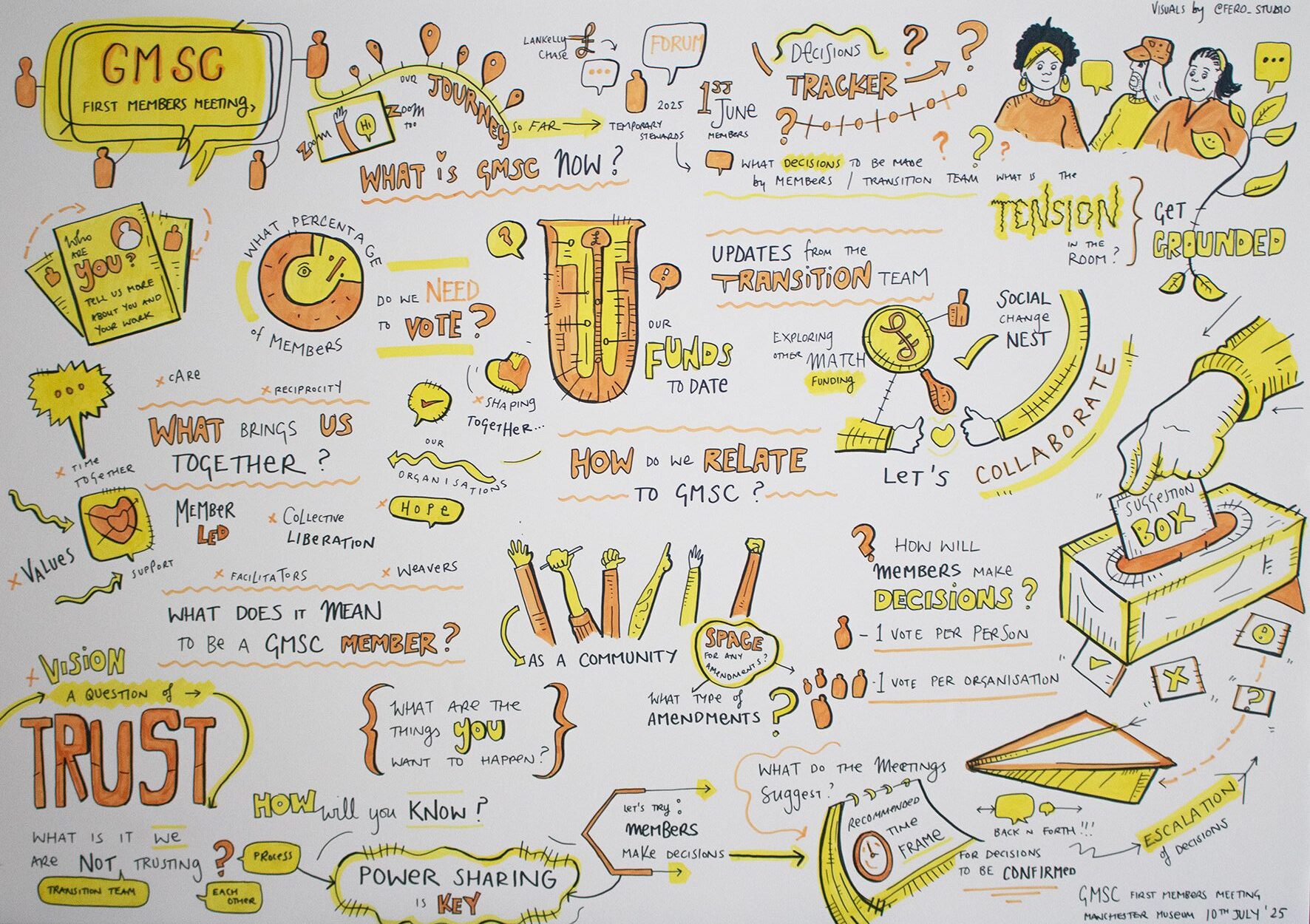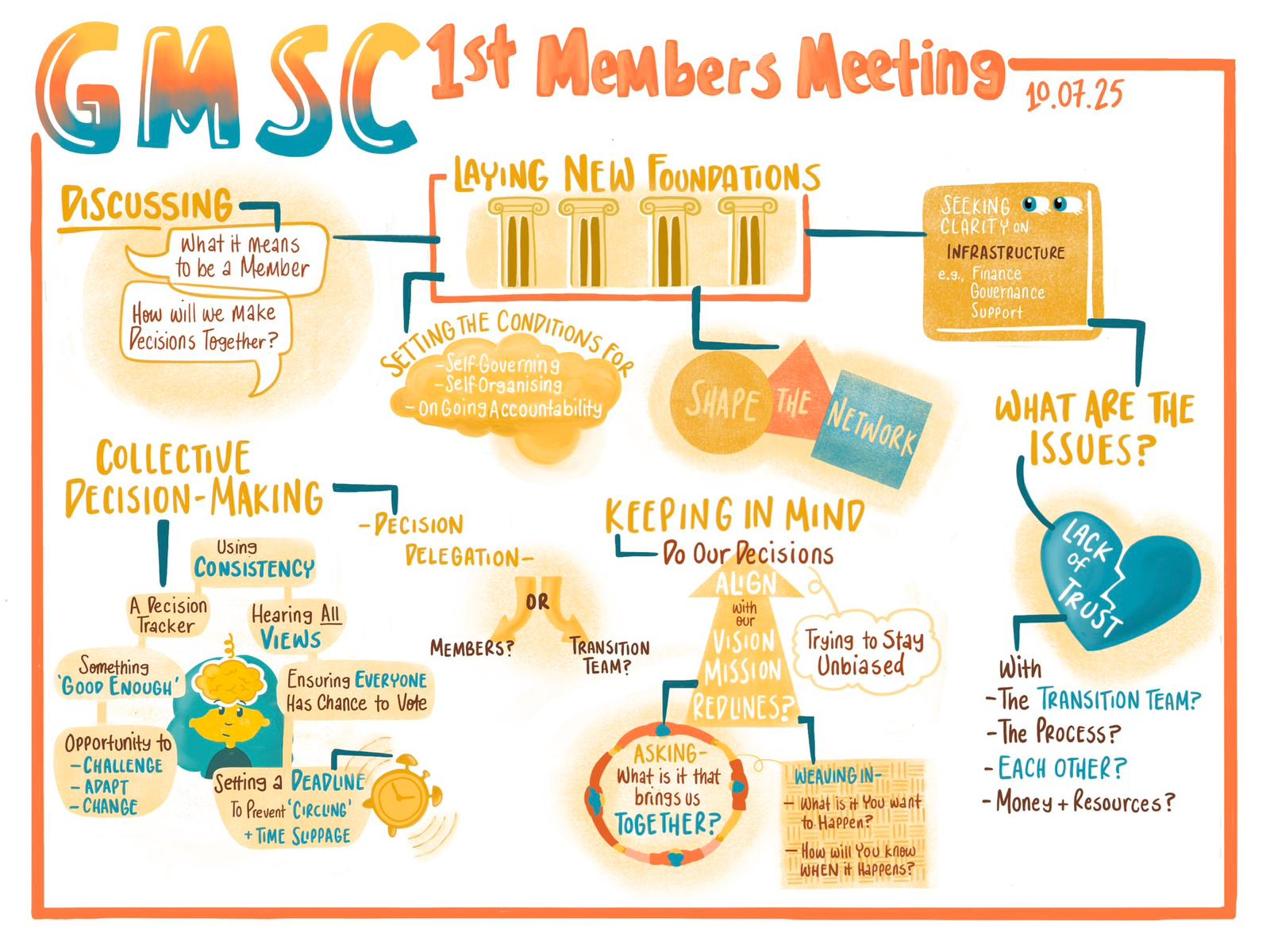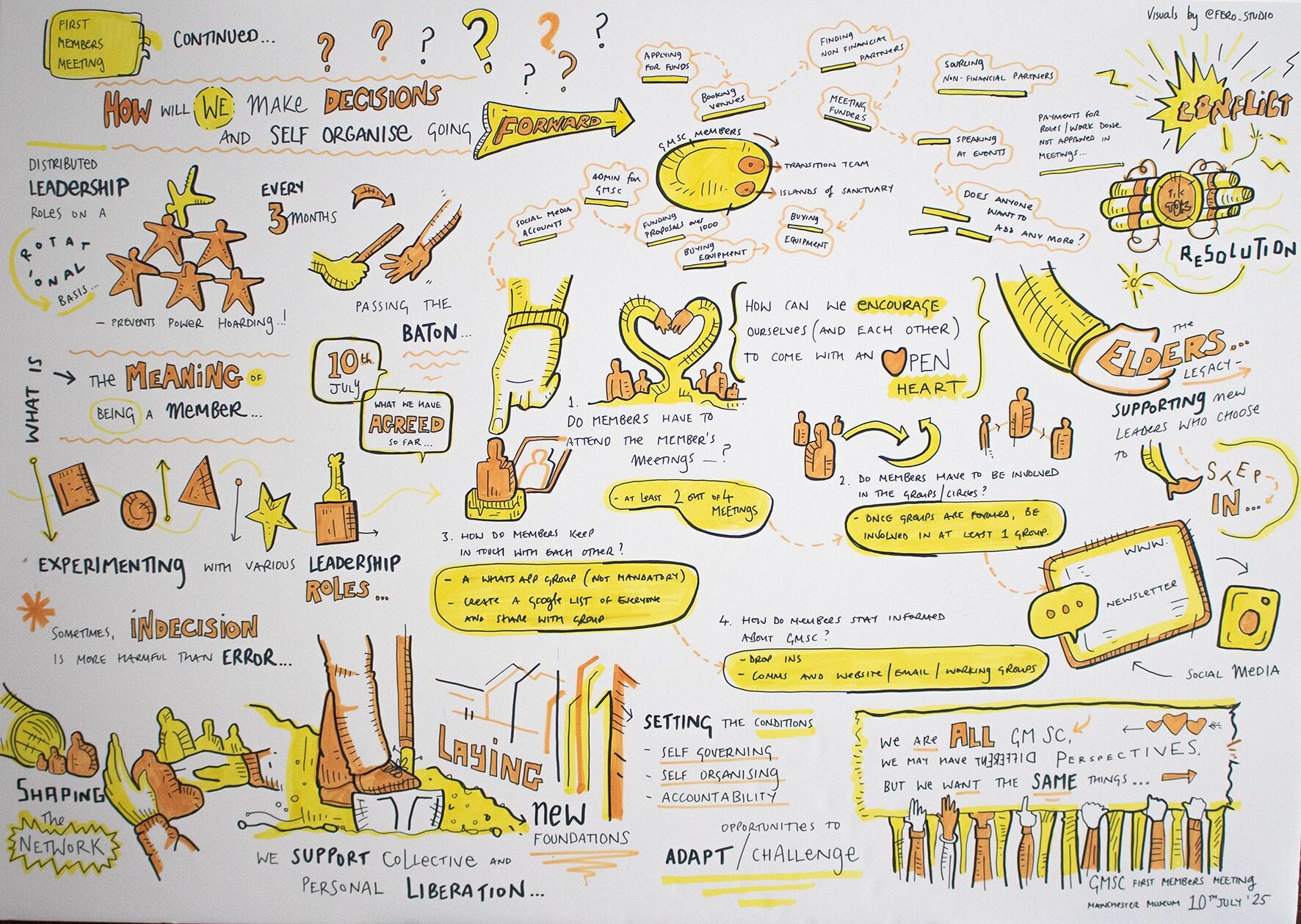
Date and place:, 10th of July, Top floor, Manchester Museum
In attendance in person or on zoom:
42 Street, Afrocats, afshan, Elevate young minds, Caring and Sharing Rochdale, Ceebee Gold Foundation, de Butterflies, Dipact (2), Global Arts (2), Jengba (2), Mama Health (2), Northern lily, OBADO, Out Agency, Paolo, Rachael, RAPAR (2), SAWN (2), Selva, Shamshad, Theatre in Flow (2), Unlimited Potential, Women’s voices, Virginie, Viv, ZIWO
The Transition Team began by giving a brief overview of how GM SC became a members-led network.
Starting in 2020 GMSC has now moved from various participatory grant-making programmes led by a core team (with Lankelly Chase), to now a members-led network with no formal connection to Lankelly Chase.
List of members and their public contact details: https://gmsystemschangers.org.uk/initiatives/
Information about decisions (from January 2024) is also on the website: https://gmsystemschangers.org.uk/decisions-so-far/ This decision tracker will be updated after decisions have been made.
The agenda for today included:
- A. How do we make decisions
- B. Which decisions are delegated to whom
- C. How do we self-organise in circles
- D. How do we meet and structure our meeting
- E. What does it mean to be a member
A. How do we make decisions
We discussed how we would make decisions. Below are the recommendations of those who attended the Members’ Meeting:
- A1. By default, decisions are made by all GM SC members
- A2. Any member can suggest something, related to GM SC, for other members to decide on.
- A3. The Transition Team will help members, when needed, to shape clear and actionable proposals and prepare supporting info.
- A4. Where possible, details of proposals will be sent to members in advance.
- A5. Members will agree on their stance with others in their organisation and respond with any questions or objections/amendments.
- A6. Each proposal will be discussed in the members meeting & members will share their recommendations (aligned with our vision, mission, values & red lines).
- A7. Proposals will be sent to all members to vote on, with a clear and generous deadline
- A8. Each organisation gets one vote. (You can discuss in your organisation, and harvest any insights before you vote).
- A9. We will aim for 100% participation. The Transition Team will follow up with anyone who hasn’t responded to offer support. Final decisions will be based on the votes received by the deadline. There will be no set quorum.
- A10. The vote, objections and comments will be recorded and visible to all members.
- A11. After the vote, the transition team will contact people who didn’t get the decision they wanted to ask what would it take to come along.
- A12. Objections and comments may come into the next members meeting as new proposals.
- A13. We will regularly review decisions made to check how it is going, the impact, any improvements etc, and bring that back to members’ meetings. (The details of this need to be developed).
This meant that we agreed today that no decisions would be made during this Members’ Meeting. Instead, the Transition Team will send all the recommendations discussed to all members for approval via an online vote afterwards. If members choose to continue with this approach, the same process will be used for the next Members’ Meeting.
We then tried to do an activity where we tried to delegate certain decisions to different groups (transition team, a smaller working group/circle, or all members). This activity didn’t work in the large group setting. So after lunch, a decision was made to split up into two smaller groups. One was tasked to make recommendations related to delegating decisions and the other was tasked to make recommendations about what it means to be a member, and what it takes to become one.

B. Which decisions are delegated to whom (recommendation by group 1)
Earlier, members present at the Members’ Meeting recommended that, by default, decisions will be made by all members.
B1. The members’ meeting suggestion was to delegate the following decisions to the Transition Team:
- Funding proposals under £1000
- Buying equipment/materials under £1000
- Answering emails that come in to GMSC
- Running the website and social media accounts
- Finding 3 available venues to offer
- Booking in venue/catering for meetings under £1000
B2. The Members’ Meeting suggestion was that all members’ decisions should include:
- Funding proposals over £1000
- Buying equipment/materials/venue (over £1000)
- Any payment for roles/work needed (that’s not already approved)
- Decision on which venue we use (from available shortlist)
- Prioritising what goes onto the agenda for members meetings
- Anything else we haven’t agreed to delegate
B3. The Member’s Meeting suggestion was that all members should be informed of the following, and can choose to step in:
- Meeting funders
- Finding non-financial partnerships
- Applying for funding (from outside of GMSC)
- Speaking at events on GMSC behalf
C. How do we self-organise in circles (recommendation by group 1)
On the 17th of April 2025, the Temporary Stewards decided that members will be able to form circles/groups to focus on specific areas. Those circles can be started by 3 different people from 3 different member organisations, and they can request funding/support and may have budget lines on GM SC account with Social Change Nest.
During the July’s Members’ Meeting, members added the following recommendation related to self-organising circles in GM SC.
- C1. Each circle will have a name and clear purpose.
- C2. Each circle commits to bringing an update to each members’ meeting.
- C3. Each circle will have a WhatsApp group in the GM SC WhatsApp Community or a Google Group. The join link will be shared so that other members can join.
- C4. If a circle wants to request resources from the GMSC pot, they will put in a proposal, which will go through our decision-making process.
- C5. The circle will hear back the result of the decision-making process and any objections/suggestions/feedback.
- C6. The circles can end at any time when there is no longer a need or no longer 3 members from 3 different organisations actively engaged.

D. How do we meet and structure our meeting (recommendation by group 1)
The Members’ Meeting recommends that we meet and structure our meeting in the following way:
- D1. There will be a standard structure for meetings including welcome, check in, updates, and check out.
- D2. Before each meeting, any member can propose an item they would like to discuss.
- D3. All members will be invited to vote in advance to rank the agenda items by priority, using an online system (to be developed).
- D4. The meeting will start with the highest priority items, as not everyone can stay all day. The afternoon will focus on discussion and idea development.
E. What does it mean to be a member (recommendation from group 2)
Group two discussed what it means to be a member. They recommend the following:
- E1. Members are to attend at least 2 meetings (in person or online) a year.
- E2. Once working groups and circles have been set up, each member must be actively part of at least one working group.
- E3. Each member must be contactable by other members via either WhatsApp or email (their choice). For this, they will provide at least one contact to be added to the WhatsApp Group or a shared Google Group (email list), which will be visible to all members.
- E4. The Transition Team will hold drop-ins after each Members’ Meeting to update anyone who couldn’t attend. They will also share the minutes and decisions log on the GM SC website. And it is each member’s responsibility to stay in touch and catch up on what they missed
- E5. Members can write blog posts about GM SC working groups that can be shared on the website.
The 2nd group ran out of time to consider the following points related to membership, which means they will be discussed at the next Members’ Meeting:
- Are members expected to contribute financially?
- Are members expected to contribute in kind (i.e. time/skills/space)?
- How will members resolve conflict and hold each other to account?
- How can someone/organisation join the GMSC network?
- What is the structure of the GMSC network? (i.e. every member is equal; or there are active members and supporting members)
- How do members share GMSC resources? (i.e. anyone connected to us, or only members)

F. Other ideas members can develop for the next Members’ Meeting:
The below ideas were touched on during the July’s Members’ meeting but we didn’t have time to explore them. They are listed below and any member can develop them and bring them as a proposal for members to discuss during the next Members’ Meeting.
CONFLICT TRANSFORMATION: When there is an action that has a negative impact and we can’t resolve in the moment (we are over capacity), anyone can call a time out. We will have an object in the room for this so people don’t have to find words. The people involved are offered support to process this and restore trust). We have some budget for this support and people within the membership that have this skill, there may be others who want to do this. We could also use external mediators if needed. Let the transition team know if you need this support until we have agreed a clear system.
ROLLING LEADERSHIP / FACILITATION: Every 6 months, members that would like to be part of the facilitation/leadership team can put their name forward. The current / previous team will help support them – handover and mentorship.
TRIADS/PEER GROUPS: We might want to revisit the idea of having peer groups that meet regularly between members meetings for support and accountability.
SOCIALS: Any member can suggest a social / gathering.
Resource list and skills audit: Haleh has offered to start this, Viv to help if needed, then share with members.
Social Change Nest boundaries related to their recent legal guidance: any members can organise a specific meeting to discuss this further and bring it back as a proposal to members.
Storytelling circle: any 3 members from 3 different organisations can organise as a circle to oversee updates to the website.
Having a secretary general or a board of trustees as ultimate decision makers, where members can’t decide: any member can organise a specific meeting to discuss this further and bring back as a proposal to members.
A space to explore our power dynamics: any member can offer this space.
